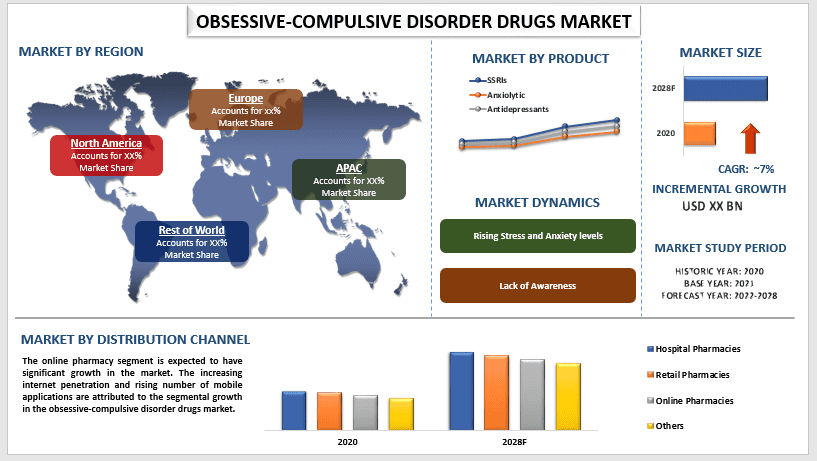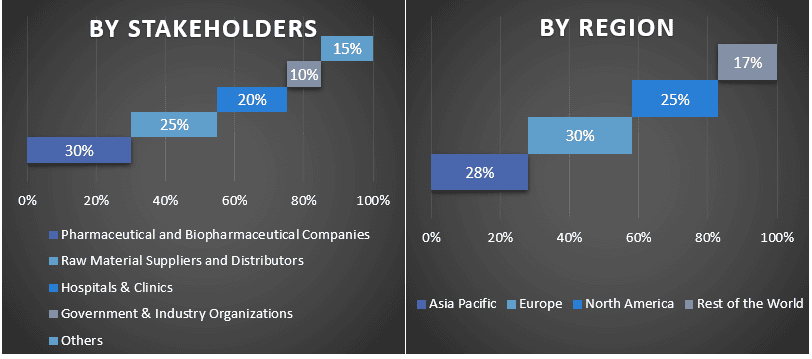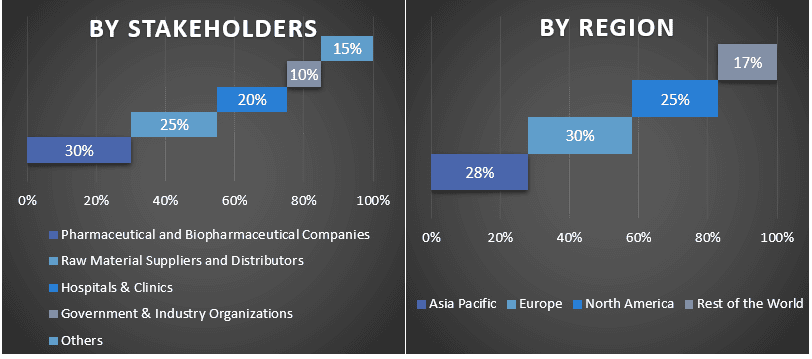Emphasis on Drug Type (SSRIs, Anxiolytic, and Antidepressants)); Distribution Channel (Hospital Pharmacies, Retail Pharmacies, Online Pharmacies, and Others)); Region (North America, Europe, Asia-Pacific, Rest of the World); and Region/Country

The global obsessive-compulsive disorder drugs market is expected to grow at a significant rate of around 7% during the forecast period. OCD is a long-lasting mental health condition characterized by frequent thoughts or urges and repetitive behaviors or actions that people feel like they continue doing repeatedly. The rising prevalence of obsessive-compulsive disorder and increasing work-related stress are important factors that are responsible for the market growth of OCD drugs. For instance, as per the NIMH, OCD affects 2.5 million adults, or 1.2% of the U.S. population. Furthermore, the rising awareness about the severity of the disease among the population also catalyzes the market dynamics of their OCD drugs.
Abbott, Pfizer Inc., Merck & Co. Inc., Sanofi, Novartis AG, AbbVie Inc., Eli Lilly and Company, AstraZeneca, Meiji Holdings Co., Ltd, Brainsway are some of the key players in the market. Several M&As along with partnerships have been undertaken by these players to facilitate customers with hi-tech and innovative products/technologies.
Insights Presented in the Report
“Amongst drug type, antidepressant category to witness higher CAGR during the forecast period”
Based on the drug type, the market has been categorized into SSRIs, anxiolytic, and antidepressants. The antidepressants category is to witness higher CAGR during the forecast period owing to rapidly increasing cases of mental disorders which were further increased by the lockdowns imposed during the COVID-19 pandemic. For instance, according to the WHO, the burden of mental health problems in India is 2,443 disability-adjusted life years (DALYs) per 10,000 population.
“Amongst distribution channel, the online pharmacies to hold a significant share in the market in 2020”
Based on the distribution channel, the market has been categorized into hospital pharmacies, retail pharmacies, online pharmacies, and others. Among these, online pharmacies to hold a significant share in the market in 2020. The rising number of quick commerce platforms and increasing investment in online pharmacies are the important factors that are responsible for the segmental growth in the obsessive-compulsive disorder drugs market.
“North America to hold a significant share in the market”
For a better understanding of the market adoption of the obsessive-compulsive disorder drugs industry, the market is analyzed based on its worldwide presence in the countries such as North America (United States, Canada, and the Rest of North America), Europe (Germany, France, Italy, Spain, United Kingdom and Rest of Europe), Asia-Pacific (China, Japan, India, Australia, and Rest of APAC), and Rest of World. In 2020, North America held a significant share of the global obsessive-compulsive disorder drugs market. This is mainly attributed to the rising number of product launches and the increasing healthcare investments in the region. For instance, in August 2021, Drug firm Alembic Pharmaceuticals received final approval from the US health regulator for Clomipramine Hydrochloride capsules, used for the treatment of obsessions and compulsions in patients with obsessive-compulsive disorder (OCD).
Reasons to buy this report:
Customization Options:
The global obsessive-compulsive disorder drugs market can further be customized as per the requirement or any other market segment. Besides this, UMI understands that you may have your own business needs, hence feel free to connect with us to get a report that completely suits your requirements.
1. Market Introduction
2. Research Methodology Or Assumption
3. Market Synopsis
4. Executive Summary
5. Impact Of Covid-19 On The Obsessive-compulsive Disorder Drugs Market
6. Obsessive-compulsive Disorder Drugs Market Revenue (usd Bn), 2020-2028f
7. Market Insights By Drug Type
8. Market Insights By Distribution Channel
9. Market Insights By Region
10. Obsessive-compulsive Disorder Drugs Market Dynamics
11. Obsessive-compulsive Disorder Drugs Market Opportunities
12. Obsessive-compulsive Disorder Drugs Market Trends
13. Demand And Supply-side Analysis
14. Value Chain Analysis
15. Competitive Scenario
16. Company Profiled
17. Disclaimer
Research Methodology for the Obsessive-Compulsive Disorder Drugs Market Analysis (2022-2028)
Analyzing the historical market, estimating the current market, and forecasting the future market of the global obsessive-compulsive disorder drugs market were the three major steps undertaken to create and analyze the adoption of obsessive-compulsive disorder drugs in major regions globally. Exhaustive secondary research was conducted to collect the historical market numbers and estimate the current market size. Secondly, to validate these insights, numerous findings and assumptions were taken into consideration. Moreover, exhaustive primary interviews were also conducted, with industry experts across the value chain of the global obsessive-compulsive disorder drugs market. Post assumption and validation of market numbers through primary interviews, we employed a top-down/bottom-up approach to forecasting the complete market size. Thereafter, market breakdown and data triangulation methods were adopted to estimate and analyze the market size of segments and sub-segments of the industry pertains to. Detailed methodology is explained below:
Analysis of Historical Market Size
Step 1: In-Depth Study of Secondary Sources:
Detail secondary study was conducted to obtain the historical market size of the obsessive-compulsive disorder drugs market through company internal sources such as annual reports & financial statements, performance presentations, press releases, etc., and external sources including journals, news & articles, government publications, competitor publications, sector reports, third-party database, and other credible publications.
Step 2: Market Segmentation:
After obtaining the historical market size of the obsessive-compulsive disorder drugs market, we conducted a detailed secondary analysis to gather historical market insights and share for different segments & sub-segments for major regions. Major segments are included in the report as drug type and distribution channel. Further country-level analyses were conducted to evaluate the overall adoption of testing models in that region.
Step 3: Factor Analysis:
After acquiring the historical market size of different segments and sub-segments, we conducted a detailed factor analysis to estimate the current market size of the obsessive-compulsive disorder drugs market. Further, we conducted factor analysis using dependent and independent variables such as drug type and distribution channel of obsessive-compulsive disorder drugs. A thorough analysis was conducted for demand and supply-side scenarios considering top partnerships, mergers and acquisitions, business expansion, and product launches in the obsessive-compulsive disorder drugs market sector across the globe.
Current Market Size Estimate & Forecast
Current Market Sizing: Based on actionable insights from the above 3 steps, we arrived at the current market size, key players in the global obsessive-compulsive disorder drugs market, and market shares of the segments. All the required percentage shares split, and market breakdowns were determined using the above-mentioned secondary approach and were verified through primary interviews.
Estimation & Forecasting: For market estimation and forecast, weights were assigned to different factors including drivers & trends, restraints, and opportunities available for the stakeholders. After analyzing these factors, relevant forecasting techniques i.e., the top-down/bottom-up approach were applied to arrive at the market forecast for 2028 for different segments and sub-segments across the major markets globally. The research methodology adopted to estimate the market size encompasses:
Market Size and Share Validation
Primary Research: In-depth interviews were conducted with the Key Opinion Leaders (KOLs) including Top Level Executives (CXO/VPs, Sales Head, Marketing Head, Operational Head, Regional Head, Country Head, etc.) across major regions. Primary research findings were then summarized, and statistical analysis was performed to prove the stated hypothesis. Inputs from primary research were consolidated with secondary findings, hence turning information into actionable insights.
Split of Primary Participants in Different Regions

Market Engineering
The data triangulation technique was employed to complete the overall market estimation and to arrive at precise statistical numbers for each segment and sub-segment of the global obsessive-compulsive disorder drugs market. Data was split into several segments & sub-segments post studying various parameters and trends in the areas of drug type and distribution channel in the global obsessive-compulsive disorder drugs market.
The main objective of the Global Obsessive Compulsive Disorder Drugs Market Study
The current & future market trends of the global obsessive-compulsive disorder drugs market were pinpointed in the study. Investors can gain strategic insights to base their discretion for investments on the qualitative and quantitative analysis performed in the study. Current and future market trends determined the overall attractiveness of the market at a regional level, providing a platform for the industrial participant to exploit the untapped market to benefit from a first-mover advantage. Other quantitative goals of the studies include:

Customers who bought this item also bought